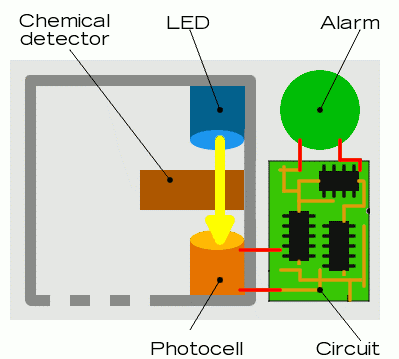Starting from the dryer machine to a chimney or generators or water heaters which use gas, oil or wood can be sources of carbon monoxide sources inside the house.
Carbon monoxide detectors fortunately, reduce the risk of carbon monoxide poisoning. They can be dealt with by placing these CO detectors in the home.
Carbon monoxide is a noiseless killer and there is no denying about it.
However, do you often wonder what is the mechanism behind the working of these CO detectors? If yes, then read more to know how a carbon monoxide detector works.
How do Carbon monoxide detectors work? Explained
The working mechanism behind these detectors which protect us from the fatal carbon monoxide poisoning is not so complicated.
Basically, the CO detectors use varied types of sensors to detect the presence of carbon monoxide in the environment. However, the basic idea on which most operate are similar.
For the most part the CO detectors which use electrochemical sensors make use of the concept as to how the chemical reacts when the presence of carbon monoxide is detected. These work in a simple fashion.
The carbon monoxide alarm consists of a sensor with three electrodes. These electrodes are immersed in an electrolyte, which is a chemical in a container.
When a small voltage is applied between electrodes and carbon monoxide releases an electron and a small current after reacting with oxygen.
This small current produced when carbon monoxide enters the sensor and reacts with oxygen is the basic idea behind the working of a CO detector. It triggers a warning alarm when the current reaches a certain threshold. These are the most efficient type of CO detectors.
Along with the accurate readings that the CO detectors which use electrochemical sensors provide these CO detectors have the greatest life span as compared to the other types of detectors.
Similarly, for other CO detectors which are semiconductor type a similar process is used.
These carbon monoxide detectors simply send the audible alarm sounds when the CO interferes with the normal functioning inside the detector.
In the case of a biomimetic CO detector, they use the simple concept of color-changing liquids in order to indicate the presence of the deadly carbon monoxide.
Most of these carbon monoxide sensors are plug-in detectors or battery operated.
Some of the detectors also used audible and visual both sensors, which means that they not only detect the presence of the high levels of carbon monoxide but additionally display the amount of carbon monoxide levels digitally.
Ensure your carbon monoxide detector(s) are working properly
After having understood the basic concept of how CO detectors work, I also recommend understanding what can be done on a regular basis so that the proper functioning of CO detectors is not hampered.
It is important to make sure if the CO detector is not affected by excessive spillage, which can be caused by strong winds, or operating several gas appliances at the same time.
This can be taken care of by placing the CO detector properly.

